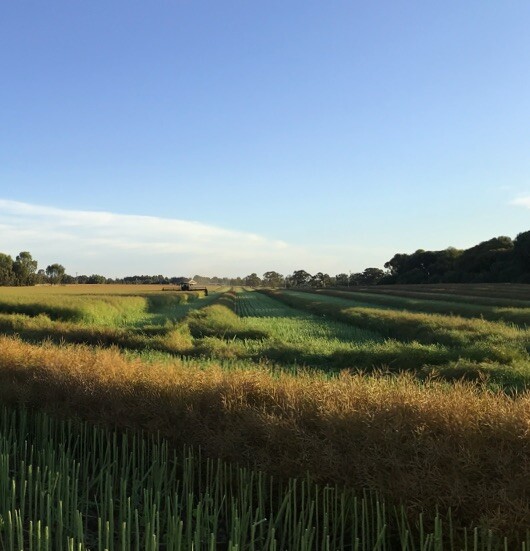Windrowing vs direct-heading canola
Factors to consider when making a decision to windrow or direct-head canola.

Key messages
- Monitor canola for seed colour change, both on the main stem and branches, to determine the optimum windrowing time
- Contractor availability, trafficability & heavy, lodged crops may compromise windrowing
- Direct-heading may provide an alternative to windrowing in some situations.
Riverine Plains region farmers would usually be busy gearing up for windrowing at this time of year, however the cool and wet conditions have delayed canola maturity and caused a host of other issues.
This may raise questions about the value and practicality of windrowing, especially where there are concerns about lodged crops, paddock access or contractor availability. So, what are the key things to think about?
Why windrow? A recap
Windrowing speeds up canola maturity by allowing the top pods to be harvested at the same time as the lower pods. Placing windrows on stubble allows air to circulate and pods/seeds can dry up to 7–10 days faster than a standing crop. Reducing the time to harvest can be important in the Riverine Plains, where heavy crops are common, because it can help avoid adverse weather and shattering losses due to rain, wind or hail.
On the flip-side, windrowing requires a specialised machinery pass, which adds to the cost. Where windrowing is delayed due to contractor unavailability or poor timing from inaccurate colour-change determinations, losses can result.
When to windrow: measuring seed colour change
Physiological maturity in canola occurs when the seed moisture content reaches 35–45%. Windrowing should be timed for when the estimated seed colour change from green to red to black is 40-60%.
Measuring colour change on the main stem only (previous industry practice) can overestimate seed colour change and mean that windrowing occurs too early. This can lead to smaller grain and potential yield reductions of up to 30%, as well as lower oil. Around 75% of grain yield is contributed by branches, with seed colour change starting later than on the main stem, so it’s important to include branches when estimating colour change. For tips on collecting a representative sample, see GRDC windrow on time.
Concerns with windrowing this season
The optimal windrowing window lasts for 4–6 days in most areas. For each day windrowing is delayed past the optimum, the more susceptible the crop is to shattering losses. Delays are a particular risk this year due to contractor backlogs or trafficability issues.
Heavy crops may also be lodged and difficult to windrow. This can lead to poorly formed/uneven windrows with ‘lumps’ or ‘haystacks’ that may not dry down effectively and can be harder to feed into the harvester, causing blockages.
Another concern will be how long canola may need to remain in the windrow before harvest, especially if regular rain fronts continue, and whether the windrow will deteriorate during that time.
Given the current conditions, some farmers may consider direct heading as a potential alternative to windrowing.
Direct heading
Direct heading canola is more common in lower-yielding environments, however, there has been a shift as higher yielding areas are trialing the practice. Growers now have access to a greater range of varieties with different maturities, shorter pod maturation periods, shorter statures and greater tolerance to pod-shattering, making direct-heading a more realistic alternative.
Direct heading removes the need for an additional machinery pass (which may reduce costs) and reduces the reliance on contractors. Where pod shattering is a concern, the application of pre-harvest treatment aids may be helpful (though these can be expensive to apply and results in some Australian trials have been inconsistent).
Direct heading may also be an option for heavy crops that are lodged and can't be windrowed.
Canola is ready to be direct headed when pods are dry and when the moisture content has fallen to 8%. It is important to harvest the crop on time and ensure the header is set-up correctly to avoid shattering losses. For direct heading tips see GRDC direct heading canola factsheet
Consider that the time taken to harvest a standing crop will be greater than for windrows, and that this will be further increased for lodged crops.
Desiccation
Desiccation can be an option which also provides an opportunity to target late-maturing weed populations. Timing of desiccation should be targeted for when the crop has passed its optimal windrowing stage.
Speak to your agronomist about the best option for your situation and always follow label recommendations and withholding periods.
Author
NEWS
Keep up to date with the latest news from across the Riverine Plains.
-
Livestock
-
People
-
Grains
-
Sustainability

